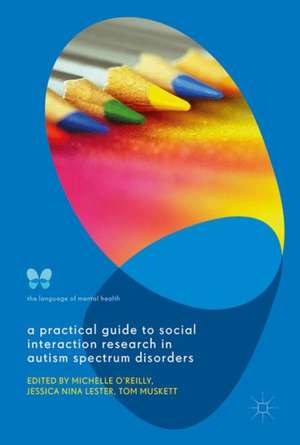A Practical Guide to Social Interaction Research in Autism Spectrum Disorders: The Language of Mental Health
Editat de Michelle O'Reilly, Jessica Nina Lester, Tom Musketten Limba Engleză Hardback – 27 noi 2017
Presented in two parts, this innovative volume first provides a set of pedagogical chapters to develop the reader's knowledge and skills in using these approaches, before moving to showcase the use of discursive methods through a range of original contributions from world-leading scholars, drawn from a range of disciplines including sociology, academic and clinical psychology, speech and language therapy, critical disability studies and social theory, and medicine and psychiatry.
| Toate formatele și edițiile | Preț | Express |
|---|---|---|
| Paperback (1) | 1032.81 lei 6-8 săpt. | |
| Palgrave Macmillan UK – 30 aug 2018 | 1032.81 lei 6-8 săpt. | |
| Hardback (1) | 1038.86 lei 6-8 săpt. | |
| Palgrave Macmillan UK – 27 noi 2017 | 1038.86 lei 6-8 săpt. |
Preț: 1038.86 lei
Preț vechi: 1093.53 lei
-5% Nou
Puncte Express: 1558
Preț estimativ în valută:
198.85€ • 216.07$ • 167.14£
198.85€ • 216.07$ • 167.14£
Carte tipărită la comandă
Livrare economică 21 aprilie-05 mai
Preluare comenzi: 021 569.72.76
Specificații
ISBN-13: 9781137592354
ISBN-10: 1137592354
Pagini: 362
Ilustrații: XXI, 362 p. 8 illus., 6 illus. in color.
Dimensiuni: 148 x 210 mm
Greutate: 0.61 kg
Ediția:1st ed. 2017
Editura: Palgrave Macmillan UK
Colecția Palgrave Macmillan
Seria The Language of Mental Health
Locul publicării:London, United Kingdom
ISBN-10: 1137592354
Pagini: 362
Ilustrații: XXI, 362 p. 8 illus., 6 illus. in color.
Dimensiuni: 148 x 210 mm
Greutate: 0.61 kg
Ediția:1st ed. 2017
Editura: Palgrave Macmillan UK
Colecția Palgrave Macmillan
Seria The Language of Mental Health
Locul publicării:London, United Kingdom
Cuprins
Chapter 1. Autism Spectrum Disorder: An introduction; Karim.- Chapter 2. Social constructionism, Autism Spectrum Disorder and the discursive approaches; O’Reilly and Lester.- Chapter 3. Naturally occurring data versus researcher generated data; Lester, Muskett, & O’Reilly.- Chapter 4. Using conversation analysis to assess the language and communication of people on the autism spectrum: A case-based tutorial; Muskett.- Chapter 5. Understanding the autistic individual: A practical guide to discourse analysis; Charlotte Brownlow, Lindsay O’Dell & Tanya Machin.- Chapter 7. How to use research supervision in the development of a discursive psychology or conversation analysis project to study Autism; Smart and Denman.- PART II.- Chapter 8. The interaction is the work: rehabilitating risk in a forensic patient with Autism Spectrum Disorder and Learning Disability; Dobbinson.- Chapter 9. Children’s use of I don’t know during clinical evaluations for autism spectrum disorder: responses to emotion questions; Stickle, Duck, and Maynard.- Chapter 10. Discursive methods and the cross-linguistic study of ASD: A conversation analysis case study of repetitive language in a Malay-speaking child; Mohamed Zain, Muskett and Gardner.- Chapter 11. Conversation Analysis: A tool for analysing interactional difficulties faced by children with Asperger’s syndrome; Rendle-Short.- Chapter 12. Animating characters and experiencing selves: a look at adolescents with autism spectrum disorder constructing fictional storyboards with typically developing peers; Bottema-Beutel, Sterponi, & Louick.
Recenzii
“A Practical Guide to Social Interaction Research in Autism Spectrum Disorders is a simple, accessible introduction to the study of Autism Spectrum Disorders (ASD) with discourse-oriented approaches. … This book is an invaluable resource for both new students of discourse and more experienced discursive researchers who are thinking about applying discursive methods to studying ASD. … Overall the book is a nice introduction to the discursive turn in critical mental health and autism research.” (Gates Henderson, Qualitative Methods in Psychology/QMiP Bulletin, Issue 27, 2019)
“With its rich and innovative content, this book is a comprehensive reference to the range of language-focused approaches currently being used in research on neurological disorders. Newcomers from related fields also will find much of value in this collection, which hopefully will spark an increase in the number and quality of related projects.” (Yanhua Cheng, Discourse Studies, Vol. 20 (05), October, 2018)
Notă biografică
Michelle O’Reilly is a Senior Lecturer for the Greenwood Institute of Child Health at the University of Leicester, and Research Consultant for Leicestershire Partnership NHS Trust. Michelle’s research interests are broadly in child mental health, family therapy, and the sociology of health and illness.
Jessica Nina Lester is an Assistant Professor of Inquiry Methodology in the School of Education at Indiana University, USA. She teaches research methods courses, including discourse analysis, with much research focused on the study and development of qualitative methodologies and methods.
Tom Muskett is a Senior Lecturer in Psychology at Leeds Beckett University, UK. He has worked in clinical and educational roles with children with diagnoses of autism and their families, and previously led a clinical training programme at the University of Sheffield, UK.
Textul de pe ultima copertă
This book introduces a novel approach for examining language and communication in autism spectrum disorder (ASD) - discourse and conversation analysis. The authors offer a set of very different perspectives on these complex issues than are typically presented in psychological and clinical work. Emerging from a range of social scientific fields, discourse and conversation analysis involve fine-grained qualitative analysis of naturally-occurring, rather than laboratory-based, interaction, enabling broad applications. Presented in two parts, this innovative volume first provides a set of pedagogical chapters to develop the reader's knowledge and skills in using these approaches, before moving to showcase the use of discursive methods through a range of original contributions from world-leading scholars, drawn from a range of disciplines including sociology, academic and clinical psychology, speech and language therapy, critical disability studies and social theory, and medicine and psychiatry.
Caracteristici
Highlights the economic consequences of a disabling culture Aims to layer and complicate the discussions that surround autism in schools, health clinics and society Illustrates social construction of autism in educational and historical discourses









